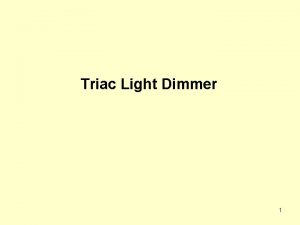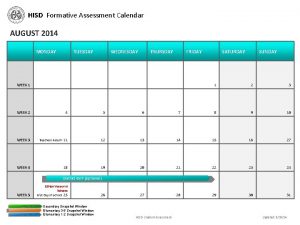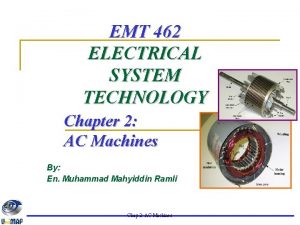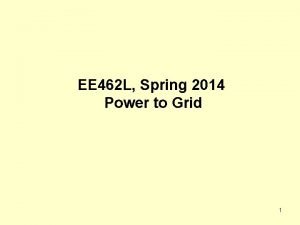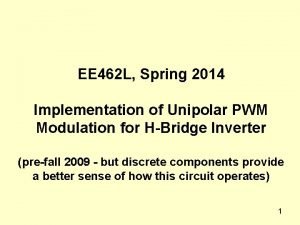EE 462 L Spring 2014 Triac Light Dimmer














- Slides: 14

EE 462 L, Spring 2014 Triac Light Dimmer 1

Triac Light Dimmer Light bulb a b Triac (front view) 3. 3 kΩ + Van (from Variac) – c Bilateral trigger diode (diac) n + Van – n Light bulb + 0 V – • Efficient Triac G MT 1 0. 1µF a • Simple MT 2 250 kΩ linear pot + Van – Before firing, the triac is an open switch, so that practically no voltage is applied across the light bulb. The small current through the 3. 3 kΩ resistor is ignored in this diagram. • Inexpensive MT 1 MT 2 G a b • Ingenious + Van – n Light bulb + Van – b + 0 V – After firing, the triac is a closed switch, so that practically all of Van is applied across the light bulb. 2

! Triac Open When the voltage across the diac reaches about ± 35 V, it self-fires and its voltage collapses to about ± 5 V Light bulb 3. 3 kΩ + Van (from Variac) – 250 kΩ linear pot 0. 1µF Triac Closed Bilateral trigger diode (diac) + Van (from Variac) – Capacitor discharges into triac gate Light bulb 3. 3 kΩ 250 kΩ linear pot 0. 1µF Bilateral trigger diode (diac) • Light bulb resistance is a few ohms when cold, and about 100 -200Ω when bright (use to get light bulb resistance R) • The light bulb resistance is small compared to the 3. 3 kΩ and potentiometer combination and can be ignored when analyzing the RC electronic circuit • The circuit resets and the process repeats every half-cycle of 60 Hz 3

#6 -32, ½” machine screw, flat washer, split washer, and hex nut Remove this center screw Flat rubber washers between #8 x 1” screws and porcelain #8 x ½” screws for corner brackets #8 x 3/4” screws for terminal blocks The potentiometer is connected so that turning it clockwise lowers the resistance of the firing circuit, fires the triac sooner, and makes the light brighter 4

To make it easy to connect an oscilloscope probe, it helps to put an extra spade connector, bent upwards at a 90° angle, under the back terminal block screws Remove this center screw 9. 6°C rise above ambient air per Watt The back of the triac fits firmly against the heat sink, with maximum surface contact. The flat washer, then split washer, then hex nut fit on the other side of the corner bracket. 5

Hookup 6

Connection to Variac 7

! No-Firing Condition – Actual Variac voltage Capacitor voltage • When potentiometer resistance is large, there is no firing because the capacitor voltage never exceeds (positive or negative) the diac breakover voltage • Capacitor voltage lags variac voltage almost 90º for large potentiometer resistance 8

No-Firing Condition – Simulated (EE 362 L_Triac_Light_Dimmer. xls) 9

! Firing Condition – Actual • Capacitor voltage Vcn does not go into steady state AC right away as Van crosses the zero axis. There is a time delay due to the RC time constant. • The RC time constant delay plus phase shift of the AC solution for Vcn determines the point at which the diac breakover is achieved 10

Firing Condition – Simulated (EE 362 L_Triac_Light_Dimmer. xls) 11

! Power to Light (per unit of sinewave, i. e. , α = 0º) 12

Remember to Calibrate Your Scope Probe 13

Magnitude of Voltage Harmonics Depends on Alpha ! 60 Hz component 180 Hz component 100 Hz Save screen snapshot #3 Measuring the d. B difference between 60 Hz and 180 Hz components of Vab = 43. 7 Vrms = 22. 1 Vrms 14
